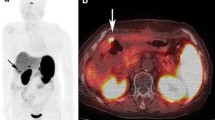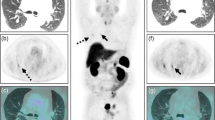Abstract
Objective
PET/CT imaging with 68Ga-1,4,7,10-tetraazacyclododecane-N,N′,N″,N‴-tetraacetic acid-D-Phe1-Tyr3-octreotide (DOTATOC) is useful in patients with neuroendocrine tumors (NETs). Functioning NETs by definition secrete abnormal levels of hormones, causing clinical symptoms. It is known that physiologic accumulation can be seen in some organs, but it remains unknown whether elevated hormone levels can affect the physiologic accumulation pattern of 68Ga-DOTATOC. We aimed to investigate the influence of higher hormone levels on physiologic accumulation of 68Ga-DOTATOC.
Methods
A total of 167 patients with known or suspected NET lesions were enrolled in this study. The numbers of patients with elevations of ACTH, gastrin, insulin, and no elevation were 10, 25, 7, and 125, respectively. We compared the maximum standardized uptake value (SUVmax) in various organs of each group.
Results
In the group with elevated ACTH levels, SUVmax in the pituitary gland, the uncinate process of the pancreas and adrenal glands was lower than those in the group with no elevation (5.7 ± 1.9 vs. 8.4 ± 3.1, P = 0.015; 4.7 ± 3.5 vs. 6.4 ± 2.8, P = 0.037; 10.8 ± 4.8 vs. 13.9 ± 4.7, P = 0.020, respectively). There were no differences in physiologic uptake of 68Ga-DOTATOC in the thyroid gland, the pancreatic body, the liver, the spleen, the bowel, or the kidney.
Conclusions
In NET patients with elevated ACTH levels, physiologic uptake of 68Ga-DOTATOC in the pituitary gland, the uncinate process of the pancreas and adrenal glands was significantly decreased. Other organs were unaffected.

Similar content being viewed by others
References
Ambrosini V, Fani M, Fanti S, Forrer F, Maecke HR. Radiopeptide imaging and therapy in Europe. J Nucl Med. 2011;52(Suppl 2):42–55.
Naswa N, Sharma P, Soundararajan R, Karunanithi S, Nazar AH, Kumar R, et al. Diagnostic performance of somatostatin receptor PET/CT using 68 Ga-DOTANOC in gastrinoma patients with negative or equivocal CT findings. Abdom Imaging. 2013;38:552–60.
Van Binnebeek S, Vanbilloen B, Baete K, Terwinghe C, Koole M, Mottaghy FM, et al. Comparison of diagnostic accuracy of 111In-pentetreotide SPECT and 68Ga-DOTATOC PET/CT: a lesion-by-lesion analysis in patients with metastatic neuroendocrine tumours. Eur Radiol. 2016;26:900–9.
Jacobsson H, Larsson P, Jonsson C, Jussing E, Grybäck P. Normal uptake of 68 Ga-DOTA-TOC by the pancreas uncinate process mimicking malignancy at somatostatin receptor PET. Clin Nucl Med. 2012;37:362–5.
Kroiss A, Putzer D, Decristoforo C, Uprimny C, Warwitz B, Nilica B, et al. 68 Ga-DOTA-TOC uptake in neuroendocrine tumour and healthy tissue: differentiation of physiological uptake and pathological processes in PET/CT. Eur J Nucl Med Mol Imaging. 2013;40:514–23.
Al-Ibraheem A, Bundschuh RA, Notni J, Buck A, Winter A, Wester HJ, et al. Focal uptake of 68 Ga-DOTATOC in the pancreas: pathological or physiological correlate in patients with neuroendocrine tumours? Eur J Nucl Med Mol Imaging. 2011;38:2005–13.
Imamura M, Nakamoto Y, Uose S, Komoto I, Awane M, Taki Y. Diagnosis of functioning pancreaticoduodenal neuroendocrine tumors. J Hepatobiliary Pancreat Sci. 2015;22:602–9.
Nakamoto Y, Sano K, Ishimori T, Ueda M, Temma T, Saji H, et al. Additional information gained by positron emission tomography with 68Ga-DOTATOC for suspected unknown primary or recurrent neuroendocrine tumors. Ann Nucl Med. 2015;29:512–8.
Kaemmerer D, Peter L, Lupp A, Schulz S, Sänger J, Prasad V, et al. Molecular imaging with 68Ga-SSTR PET/CT and correlation to immunohistochemistry of somatostatin receptors in neuroendocrine tumours. Eur J Nucl Med Mol Imaging. 2011;38:1659–68.
Miederer M, Seidl S, Buck A, Scheidhauer K, Wester HJ, Schwaiger M, et al. Correlation of immunohistopathological expression of somatostatin receptor 2 with standardised uptake values in 68 Ga-DOTATOC PET/CT. Eur J Nucl Med Mol Imaging. 2009;36:48–52.
Boy C, Heusner TA, Poeppel TD, Redmann-Bischofs A, Unger N, Jentzen W, et al. 68 Ga-DOTATOC PET/CT and somatostatin receptor (sst1–sst5) expression in normal human tissue: correlation of sst2 mRNA and SUVmax. Eur J Nucl Med Mol Imaging. 2011;38:1224–36.
Gallo-Payet N. 60 years of POMC: adrenal and extra-adrenal functions of ACTH. J Mol Endocrinol. 2016;56:135–56.
Park S, Kamegai J, Kineman RD. Role of glucocorticoids in the regulation of pituitary somatostatin receptor subtype (sst1-sst5) mRNA levels: evidence for direct and somatostatin-mediated effects. Neuroendocrinology. 2003;78:163–75.
Hofland LJ, Lamberts SW, Feelders RA. Role of somatostatin receptors in normal and tumoral pituitary corticotropic cells. Neuroendocrinology. 2010;92(Suppl 1):11–6.
Eigler T, Ben-Shlomo A. Somatostatin system: molecular mechanisms regulating anterior pituitary hormones. J Mol Endocrinol. 2014;53:1–19.
van der Hoek J, Waaijers M, van Koetsveld PM, Sprij-Mooij D, Feelders RA, Schmid HA, et al. Distinct functional properties of native somatostatin receptor subtype 5 compared with subtype 2 in the regulation of ACTH release by corticotroph tumor cells. Am J Physiol Endocrinol Metab. 2005;289:278–87.
Xu Y, Berelowitz M, Bruno JF. Dexamethasone regulates somatostatin receptor subtype messenger ribonucleic acid expression in rat pituitary GH4C1 cells. Endocrinology. 1995;136:5070–5.
Kraus J, Wöltje M, Höllt V. Regulation of mouse somatostatin receptor type 2 gene expression by glucocorticoids. FEBS Lett. 1999;459:200–4.
Kraus J, Wöltje M, Schönwetter N, Höllt V. Alternative promoter usage and tissue specific expression of the mouse somatostatin receptor 2 gene. FEBS Lett. 1998;428:165–70.
Acknowledgements
We are grateful for support from a Grant-in-Aid for Scientific Research from the Ministry of Education, Culture, Sports, Science, and Technology, Japan (16K10346). We have no conflict of interest to declare.
Author information
Authors and Affiliations
Corresponding author
Ethics declarations
Conflict of interest
We have no conflict of interest to declare other than a Grant-in-Aid for Scientific Research from the Ministry of Education, Culture, Sports, Science, and Technology, Japan (16K10346).
Electronic supplementary material
Below is the link to the electronic supplementary material.
Rights and permissions
About this article
Cite this article
Watanabe, M., Nakamoto, Y., Koyasu, S. et al. The influence of elevated hormone levels on physiologic accumulation of 68Ga-DOTATOC. Ann Nucl Med 32, 191–196 (2018). https://doi.org/10.1007/s12149-018-1233-4
Received:
Accepted:
Published:
Issue Date:
DOI: https://doi.org/10.1007/s12149-018-1233-4




